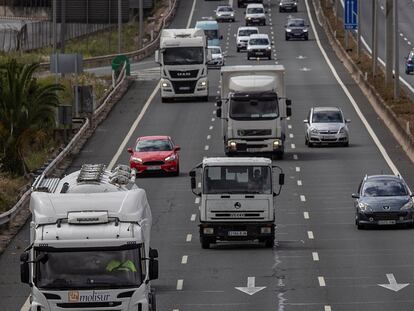More than half of Spain moving to Phase 3 of coronavirus deescalation plan on Monday
The Madrid region and the city of Barcelona will enter the second stage, which allows social gatherings of up to 15 people and lifts the restrictions on outdoor activity
The Spanish Health Ministry announced on Friday that it had approved every region’s request to move to a new stage of the coronavirus deescalation plan. This means that more than half of the country will be in Phase 3 by Monday, June 8, while Madrid region and the city of Barcelona will be allowed to enter Phase 2.
“Fifty-two percent of the population will be in Phase 3,” said Health Minister Salvador Illa at a government press conference on Friday. “We are in the final stage, but we are still in the deescalation process,” he added.
The following areas will move to Phase 3: Galicia, Asturias, Cantabria, Basque Country, La Rioja, Navarre, Aragon, Extremadura, Andalusia, Murcia, the Balearic islands of Mallorca, Menorca and Ibiza, and the Canary islands of Tenerife, Gran Canaria, La Palma, Lanzarote and Fuerteventura.
We are in the final stage, but we are still in the deescalation processHealth Minister Salvador Illa
Under the deescalation plan, each stage must be in place for a minimum of two weeks before a region can move to the next phase. This rule has been adhered to with the exception of the Andalusian provinces of Málaga and Granada, which have been granted permission to move to Phase 3 with the rest of the region, despite having only been in Phase 2 for a week.
Also moving to Phase 3 are the Catalan healthcare areas of Alt Pirineu i Aran, Terres de l’Ebre and Camp de Tarragona, and the provinces of Cuenca and Guadalajara in Castilla-La Mancha. With respect to Spain’s exclave cities in North Africa, Melilla and Ceuta, the former will move to Phase 3, while the latter decided not to request a phase change after detecting an outbreak of coronavirus cases.
Only the Canary Islands of El Hierro, La Gomera and La Graciosa, and the Balearic Island of Formentera, are currently in Phase 3, where they will remain until next week.
Under Phase 3 – which is the last step before “the new normality” – sidewalk cafes can open at 75% capacity, bars can reopen with safe-distancing measures in place, and social gatherings of up to 20 people are allowed.
Most crucially, the central government will let regional authorities take control of the deescalation process and decide how long this final period should last. Given the possibility of some regions deciding to end Phase 3 and enter the new normality before the state of alarm officially ends on June 21, Health Minister Illa said that under Phase 3, regions may decide when the state of alarm ends.
“The regional leaders will be the ones who make decisions in Phase 3 in their territory and who can request to enter the new normality,” added Finance Minister and government spokesperson María Jesús Montero at the government press conference.
The Madrid region and the city of Barcelona and its metropolitan areas – some of the places hardest hit by the outbreak in Spain – will enter Phase 2 on Monday. Under this stage, regions are able to decide whether or not classes should restart in schools, social gatherings of up to 15 people are allowed, and there are no restrictions on outdoor activity.
Also moving to Phase 2 is the Catalan comarca of Lleida, which was held back last week due to an outbreak of coronavirus cases, and the region of Castilla y León, with the exception of the Bierzo healthcare area, which moved into this stage on Monday.
In Castilla-La Mancha, the provinces of Toledo, Ciudad Real and Albacete will remain in Phase 2. The regional government of Valencia, which entered Phase 2 on Monday, was the only one not to request a phase change.
Differences between Phase 2 and Phase 3
English version by Melissa Kitson.
Tu suscripción se está usando en otro dispositivo
¿Quieres añadir otro usuario a tu suscripción?
Si continúas leyendo en este dispositivo, no se podrá leer en el otro.
FlechaTu suscripción se está usando en otro dispositivo y solo puedes acceder a EL PAÍS desde un dispositivo a la vez.
Si quieres compartir tu cuenta, cambia tu suscripción a la modalidad Premium, así podrás añadir otro usuario. Cada uno accederá con su propia cuenta de email, lo que os permitirá personalizar vuestra experiencia en EL PAÍS.
¿Tienes una suscripción de empresa? Accede aquí para contratar más cuentas.
En el caso de no saber quién está usando tu cuenta, te recomendamos cambiar tu contraseña aquí.
Si decides continuar compartiendo tu cuenta, este mensaje se mostrará en tu dispositivo y en el de la otra persona que está usando tu cuenta de forma indefinida, afectando a tu experiencia de lectura. Puedes consultar aquí los términos y condiciones de la suscripción digital.
More information
Últimas noticias
Most viewed
- Sinaloa Cartel war is taking its toll on Los Chapitos
- Oona Chaplin: ‘I told James Cameron that I was living in a treehouse and starting a permaculture project with a friend’
- Reinhard Genzel, Nobel laureate in physics: ‘One-minute videos will never give you the truth’
- Why the price of coffee has skyrocketed: from Brazilian plantations to specialty coffee houses
- Silver prices are going crazy: This is what’s fueling the rally









































